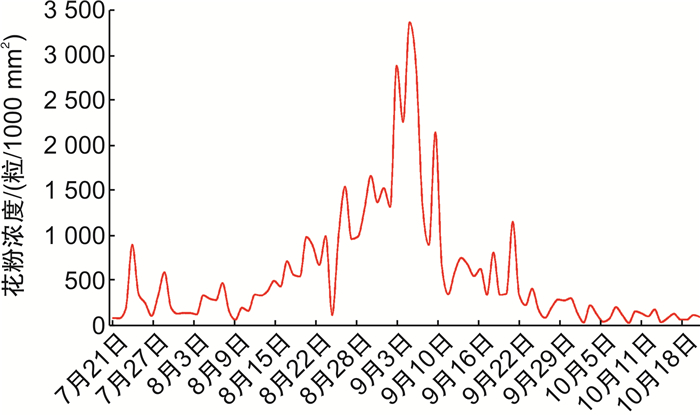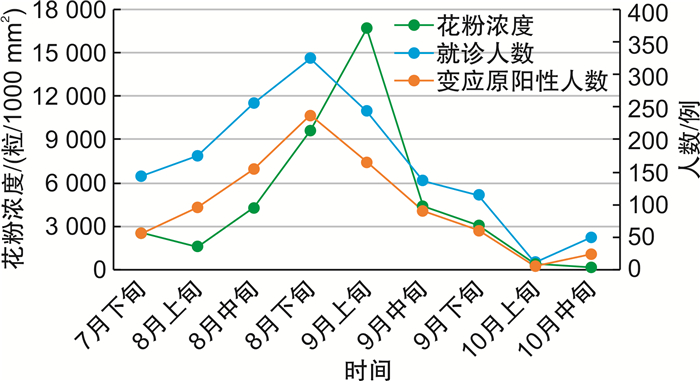A study of airborne pollen monitoring and its connection with allergic rhinitis visits in Taiyuan over the summer and autumn seasons
-
摘要: 目的 探讨太原市夏秋季气传花粉的分布情况,分析花粉特征、气象因子和过敏致敏间的关联性,为该地区过敏疾病的合理防治提供参考依据。方法 应用重力沉降法调查太原市2022年7月21日至2022年10月20日气传花粉的种类、数量及飘散规律,同时收集同期气象及诊疗患者的信息,使用SPSS 26.0软件对数据进行分析与总结。结果 ① 共收集到花粉17 118粒,鉴定到14科10属4种,太原市夏秋季花粉播散高峰期为8月下旬至9月上旬。优势气传花粉为蒿属(66.62%)、大麻/葎草属(17.79%)、国槐(8.18%)、藜/苋科(2.83%)、禾本科(2.11%),绝对优势气传花粉为蒿属(66.62%)。②太原市气传花粉浓度与一定范围内平均温度(5~20 ℃),最大温度(11~30 ℃)呈正相关(r=0.547,0.315,P < 0.05)。③太原市气传花粉含量与我院变应性鼻炎(allergic rhinitis,AR)患者就诊人次及过敏原阳性率呈正相关(r=0.702,0.747,P < 0.05)。结论 太原市夏秋季气传花粉播散高峰期为8月下旬至9月上旬。优势花粉为蒿属、大麻/葎草属、国槐、藜/苋科、禾本科,绝对优势花粉为蒿属。气象因子是影响花粉含量的重要因素。一定范围内,温度升高有利于花粉的扩散与运输。花粉粒数与AR患者就诊人次存在相关性,可作为AR患病的环境预警指标,指导AR患者及早采取预防性治疗,从而降低过敏风险。Abstract: Objective To explore the distribution of airborne pollen in summer and autumn in Taiyuan, analyze the correlation between pollen characteristics, meteorological factors and allergic sensitization, and provide for the prevention and treatment of allergic diseases in this.Methods The gravity sedimentation method was used to investigate the types, quantities and dispersion patterns of airborne pollen in Taiyuan City from July 21, 2022 to October 20, 2022. he meteorological and patient information was collected during the same period SPSS 26.0 software.Results ① A total of 17 118 pollen grains were collected, and identified as 14 families, 10 genera, and 4 species. The peak period for pollen dispersal in summer and autumn in Taiyuan City from late August to early September. airborne pollen Artemisia(66.62%), Cannabis/Humulus(17.79%), Sophora japonica(8.18%), Chenopodiaceae/Amaranthaceae(2.83%), Gramineae(2.11%). ②The concentration of airborne pollen in Taiyuan City positively correlated with the average temperature(5-20℃) and maximum temperature(11-30℃) within a certain range(r=0.547, 0.315, P < 0.05). ③The content of airborne pollen in Taiyuan City positively correlated with the number of visits and allergen positive rate of patients with allergic rhinitis(AR) in our hospital(r=0.702, 0.747, P < 0.05).Conclusion The peak period for airborne pollen dispersal during the summer and autumn seasons in Taiyuan City from late August to early September. The dominant pollen is Artemisia, Cannabis/Humulus, Sophora japonica, Chenopodiaceae/Amaranthaceae, Gramineae, and the absolute advantage pollen is Artemisia. Meteorological factors pollen content. Within a certain range, temperature the diffusion and transportation of pollen. The number of pollen grains the number of visits, which can serve as an environmental warning indicator for AR patients to take preventive, thereby reducing the risk of allergies.
-
Key words:
- allergic rhinitis /
- allergen /
- airborne pollen /
- meteorological factors
-

-
表 1 1太原地区夏秋季气传花粉的旬分布
粒 种类 7月 8月 9月 10月 含量 百分比/% 下旬 上旬 中旬 下旬 上旬 中旬 下旬 上旬 中旬 蒿属 72 115 1 055 2 840 5 104 1 090 1 000 90 39 11 404 66.62 大麻/葎草属 16 62 446 726 1 168 465 114 40 8 3 045 17.79 国槐 898 430 47 0 25 0 0 0 0 1 401 8.18 藜/苋科 15 24 108 148 142 25 8 4 11 485 2.83 禾本科 8 12 26 54 108 88 52 12 1 361 2.11 豆科 0 0 29 75 105 55 19 7 2 292 1.71 韭菜 0 0 0 0 17 30 20 1 4 73 0.43 蓼科 0 0 0 0 0 0 19 1 0 20 0.12 豚草属 1 2 1 2 3 2 0 0 0 13 0.07 沙草科 1 2 0 0 0 0 1 0 0 4 0.03 龙葵 4 0 0 0 0 0 0 0 0 4 0.02 向日葵 0 0 0 0 0 0 1 0 2 4 0.02 松属 0 0 0 0 1 0 0 0 0 1 0.01 蔷薇科 0 0 0 0 0 1 0 0 0 1 0.01 未知 4 0 1 0 3 0 2 0 0 11 0.06 合计 1 019 646 1 714 3 846 6 677 1 756 1 237 156 68 17 118 100.00 表 2 太原地区7—10月花粉浓度与气象因子相关性分析
气象因子 花粉浓度 r P 平均温度 0.547 0.000 最大温度 0.315 0.006 平均相对湿度 0.022 0.836 最大相对湿度 -0.087 0.406 最大风力 -0.196 0.060 -
[1] 汤蕊, 王良录, 尹佳, 等. 花粉症的中国历程[J]. 中国科学: 生命科学, 2021, 51(8): 901-907. https://www.cnki.com.cn/Article/CJFDTOTAL-JCXK202108004.htm
[2] Ciprandi G, Puccinelli P, Incorvaia C, et al. Allergy: An Intriguing Challenge for the Allergist[J]. Medicina(Kaunas), 2018, 54(6): 106.
[3] Idrose NS, Lodge CJ, Peters RL, et. al. The role of short-term grass pollen exposure in food skin-prick test reactivity, food allergy, and eczema flares in children[J]. Pediatr Allergy Immunol, 2022, 33(10): e13862. http://pubmed.ncbi.nlm.nih.gov/36282135/
[4] Rodríguez F, Lombardero-Vega M, San Juan L, et al. Allergenicity to worldwide invasive grass Cortaderia selloana as environmental risk to public health[J]. Sci Rep, 2021, 11(1): 24426. doi: 10.1038/s41598-021-03581-5
[5] 安羽三, 欧阳昱晖. 季节性AR的研究现状[J]. 中国耳鼻咽喉头颈外科, 2020, 27(4): 199-201. doi: 10.16066/j.1672-7002.2020.04.007
[6] 乔秉善. 中国气传花粉和植物彩色图谱[M]. 北京: 中国协和医科大学出版社, 2005: 1-298.
[7] Asero R, Ceriotti V, Bonini M. Cypress pollen allergy in Milan: the story of an ongoing growth[J]. Eur Ann Allergy Clin Immunol, 2021, 53(5): 209-213. doi: 10.23822/EurAnnACI.1764-1489.155
[8] Jeong KY, Park JW. Oak Pollen Allergy in Korea[J]. Curr Protein Pept Sci, 2022, 23(11): 721-730. doi: 10.2174/1389203723666220624141550
[9] Mohamed MF, Refaat MM, Melek NA, et al. Pollen sensitization among Egyptian patients with respiratory allergic diseases[J]. Egypt J Immunol, 2022, 29(4): 1-11. doi: 10.55133/eji.290401
[10] Lo F, Bitz CM, Hess JJ. Development of a Random Forest model for forecasting allergenic pollen in North America[J]. Sci Total Environ, 2021, 773: 145590. doi: 10.1016/j.scitotenv.2021.145590
[11] Suanno C, Aloisi I, Fernández-González D, et al. Pollen forecasting and its relevance in pollen allergen avoidance[J]. Environ Res, 2021, 200: 111150. doi: 10.1016/j.envres.2021.111150
[12] 叶世泰. 变态反应学[M]. 北京: 科学卫生出版社, 1998: 110-113.
[13] 叶世泰, 张金谈, 顾瑞金. 中国气传致敏花粉调查[M]. 北京: 北京出版社, 1991: 44-47.
[14] 中国气传致敏花粉调查领导小组. 中国气传致敏花粉调查[M]. 北京: 北京出版社, 1991: 40-42, 58.
[15] Ouyang Y, Yin Z, Li Y, et al. Associations among air pollutants, grass pollens, and daily number of grass pollen allergen-positive patients: a longitudinal study from 2012 to 2016[J]. Int Forum Allergy Rhinol, 2019, 9(11): 1297-1303. doi: 10.1002/alr.22389
[16] 张克军, 王斌全, 成娜莎, 等. 太原市30年2次花粉调查春秋季花粉变迁对比分析[J]. 中国耳鼻咽喉头颈外科, 2012, 19(8): 408-411. doi: 10.16066/j.1672-7002.2012.08.003
[17] 刘芳. 太原市中心区域空气中花粉的播散规律及支气管哮喘患者血清特异性IgE抗体检测[D]. 山西医科大学, 2011.
[18] Singh AB, Mathur C. Climate Change and Pollen Allergy in India and South Asia[J]. Immunol Allergy Clin North Am, 2021, 41(1): 33-52. doi: 10.1016/j.iac.2020.09.007
[19] 管林, 高清源, 李红星, 等. 廊坊市城区气传花粉变化特征及其与气象要素的关系[J]. 农技服务, 2021, 38(6): 93-98. https://www.cnki.com.cn/Article/CJFDTOTAL-NJFW202106042.htm
[20] 刘晓佳, 梁红宇, 邓卓怡, 等. 建立气传花粉日播报平台对变应性鼻炎防治的意义及相关因素分析[J]. 内蒙古医科大学学报, 2020, 42(6): 606-609. https://www.cnki.com.cn/Article/CJFDTOTAL-NMYX202006011.htm
[21] 孟龄, 王效科, 欧阳志云, 等. 北京城区气传花粉季节特征及与气象条件关系[J]. 环境科学, 2016, 37(2): 452-458. https://www.cnki.com.cn/Article/CJFDTOTAL-HJKZ201602010.htm
[22] 成娜莎, 张克军, 王宁, 等. 太原市中心地区夏秋季气传致敏花粉调查分析[J]. 中国医药导报, 2009, 6(22): 173-175. doi: 10.3969/j.issn.1673-7210.2009.22.105
[23] Deng SZ, Jalaludin BB, Antó JM, et. al. Climate change, air pollution, and allergic respiratory diseases: a call to action for health professionals[J]. Chin Med J(Engl), 2020, 133(13): 1552-1560. http://qikan.cqvip.com/Qikan/Article/Detail?id=7102599300
[24] Singh AB, Kumar P. Climate change and allergic diseases: An overview[J]. Front Allergy, 2022, 3: 964987.
[25] 郝红, 高锦, 张彪, 等. 变应性鼻炎患者就诊人次与花粉浓度的关系[J]. 中国中西医结合耳鼻咽喉科杂志, 2018, 26(3): 208210. https://www.cnki.com.cn/Article/CJFDTOTAL-XYJH201803014.htm
[26] 王晓艳, 田宗梅, 宁慧宇, 等. 北京城区气传花粉分布与过敏性疾病就诊关系分析[J]. 临床耳鼻咽喉头颈外科杂志, 2017, 31(10): 757-761. https://www.cnki.com.cn/Article/CJFDTOTAL-LCEH201710006.htm
[27] 李文静, 黄南, 张书辰, 等. 2017至2018年武汉城区花粉播散特征及其与变应性鼻炎患者就诊人次数的相关性研究[J]. 中华预防医学杂志, 2021, 55(5): 620-626.
-





 下载:
下载:
